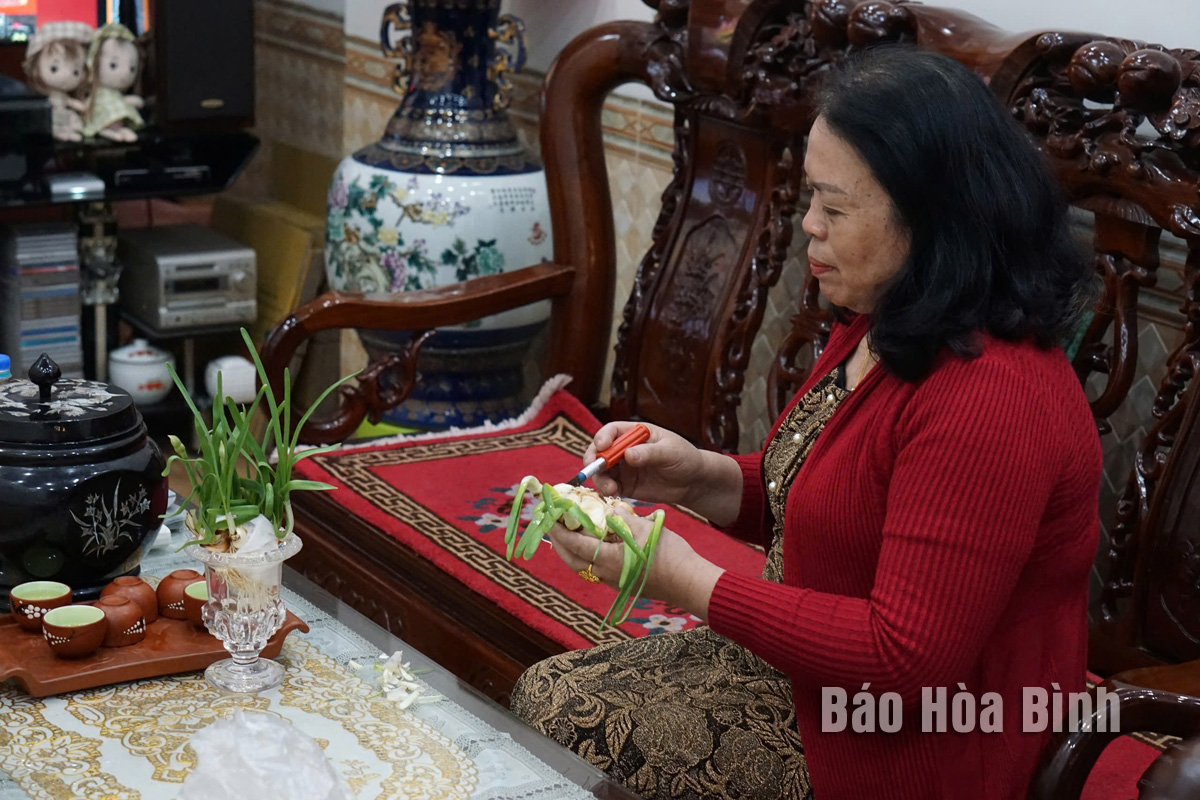
When it comes to springtime blooms, many are familiar with the vibrant pink of peach blossoms in northern Vietnam or the golden hue of apricot flowers in the south. However, there is another elegant bloom that once held sway in the historic capital of Thang Long – Hanoi, known in bygone days as Ke Cho. The pure and pristine narcissus flower, a harbinger of the Lunar New Year (Tet), is making a comeback, and its story is as captivating as its beauty.
Do Thi Phu in Hoa Binh city cares for narcissus flowers ahead of the Tet
holiday.
In today life, narcissus flowers have become more accessible to everyone,
partly due to their affordable price and because they are no longer confined to
Hanoi but have followed the footsteps of its residents to various cities and
provinces. Do Thi Phu, a Hanoi native who has been living and working in Hoa
Binh city since 1970, is one of the many people keeping this tradition alive.
Whenever the 12th lunar month comes, she seeks out Chuong Chau narcissus bulbs
for display during Tet.
According to her, the most important aspect of pruning narcissus flowers is to
avoid damaging the floral sheath as this would prevent the flowers from
blooming. Her preference lies with the single-petaled bulb variety. She
explained: "In the old days, especially during the early days of Tet, people
always wished for everything to 'rise up' and be five to ten times better than
the previous year. However, double-petaled narcissus flowers tend to bow their
heads downward, unlike single-petaled ones that stand upright. The elders
believed this posture was incomplete and less auspicious. Regarding fragrance,
single-petaled flowers emit a gentle and subtle aroma that blends harmoniously
with the scent of incense and the festive Tet atmosphere, offering a sense of
relaxation and comfort. In contrast, double-petaled flowers, while fragrant,
produce a stronger, more overwhelming scent that feels heavier and less
compatible with the Vietnamese preference for lightness and freshness".
In recent years, the tradition of cultivating narcissus flowers has gradually
gained traction among Hoa Binh residents, making these blooms a favoured choice
for Tet decorations. Local plant shops in Hoa Binh city have also begun
offering narcissus bulbs as part of their product range.
The art of appreciating narcissus flowers, dating back to the early 20th
century, is mentioned in various literary works, such as "Tet Viet Nam xua”
(Old Vietnamese Tet) by scholar Nguyen Tien Lang and the essay "To hoa" by
renowned writer Nguyen Tuan.
It can be said that thanks to its inherent beauty and deep connection with Tet,
along with improving material and spiritual lives, the tradition of narcissus
flower appreciation continues to thrive. Over time, it has become more popular
and is spreading more strongly than ever.
The clothing of women reflects the culture of the Muong, Thai, Tay, Dao, and Mong ethnic groups in the northern province of Hoa Binh.
Gongs hold a special place in the cultural and spiritual life of the Muong ethnic people in Hoa Binh province. More than musical instruments, they are an indispensable part of community rituals and collective memory, echoing through generations as a spiritual thread linking the past, present, and future.
Preserving and promoting the cultural values of the Muong ethnic group has become an urgent task in the current context, as many traditional values face the risk of fading away. This effort requires not only protecting the cultural identity but also eliminating outdated customs and developing a modern cultural lifestyle, contributing to sustainable values for the Muong community in Hoa Binh province.
The Muong ethnic culture, deeply rooted in Vietnam’s mountainous north, continues to be preserved and revitalised by dedicated individuals and communities determined to safeguard their ancestral identity.
The Muong group is one of the largest ethnic minorities in Vietnam, primarily found in Hoa Binh province. The Muong people in Hoa Binh boast a rich and diverse cultural treasure that reflects the unique identity of this ethnic group. Accounting for over 63% of the province's population, they have created and preserved numerous distinctive cultural values, contributing to their unique identity. Their cultural heritage is an invaluable asset, at the heart of their national identity, and represents a vibrant spiritual life that must be preserved and promoted in today’s modern world.
For generations, the ethnic communities of Hoa Binh province, particularly the Muong people, have preserved vibrant festivals deeply intertwined with the region’s geography, nature, and social traditions. These celebrations enrich Hoa Binh’s spiritual life and cultural identity, reflecting both folk beliefs and the intermingling of ethnic customs. Many of these festivals have endured the test of time, passed down through generations and continuing to thrive today. Among them, the Khai Ha (Going Down to the Field) festival stands out as one of the most significant events of the Muong ethnic group.



